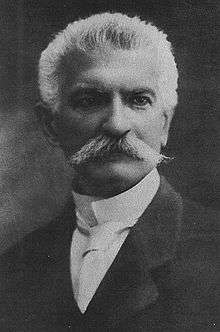Sonnino II Cabinet
The Sonnino II Cabinet held office from 11 December 1909 until 31 March 1910, a total of 110 days, or 3 months and 20 days.[1]
| Sonnino II Cabinet | |
|---|---|
47th Cabinet of Italy | |
 | |
| Date formed | 11 December 1909 |
| Date dissolved | 31 March 1910 |
| People and organisations | |
| Head of state | Victor Emmanuel III |
| Head of government | Sidney Sonnino |
| Total no. of members | 11 |
| Member party | Historical Right |
| History | |
| Predecessor | Giolitti III Cabinet |
| Successor | Luzzatti Cabinet |
Government parties
The government was composed by the following parties:
| Party | Ideology | Leader | |
|---|---|---|---|
| Historical Right | Conservatism | Sidney Sonnino | |
The cabinet was externally supported by the Historical Left.
Composition
| Office | Name | Party | Term | ||
|---|---|---|---|---|---|
| Prime Minister | Sidney Sonnino | Historical Right | (1909–1910) | ||
| Minister of the Interior | Sidney Sonnino | Historical Right | (1909–1910) | ||
| Minister of Foreign Affairs | Francesco Guicciardini | Historical Right | (1909–1910) | ||
| Minister of Grace and Justice | Vittorio Scialoja | Historical Right | (1909–1910) | ||
| Minister of Finance | Enrico Arlotta | Historical Right | (1909–1910) | ||
| Minister of Treasury | Antonio Salandra | Historical Right | (1909–1910) | ||
| Minister of War | Paolo Spingardi | Military | (1909–1910) | ||
| Minister of the Navy | Giovanni Bettolo | Military | (1909–1910) | ||
| Minister of Agriculture, Industry and Commerce | Luigi Luzzatti | Historical Right | (1909–1910) | ||
| Minister of Public Works | Giulio Rubini | Historical Right | (1909–1910) | ||
| Minister of Public Education | Edoardo Daneo | Historical Right | (1909–1910) | ||
| Minister of Post and Telegraphs | Ugo di Sant'Onofrio del Castillo | Historical Right | (1909–1910) | ||
gollark: Internals are impure.
gollark: In an ideal world, you would just tell haskell what you want and it would produce a beautiful codebase for you to marvel at, then compile ultra-optimized platform machine code for whatever you want.
gollark: Or osmarks staticicitity™.
gollark: And yet they use Haskell. Curious.
gollark: https://duckdns.org/
This article is issued from Wikipedia. The text is licensed under Creative Commons - Attribution - Sharealike. Additional terms may apply for the media files.
.svg.png)